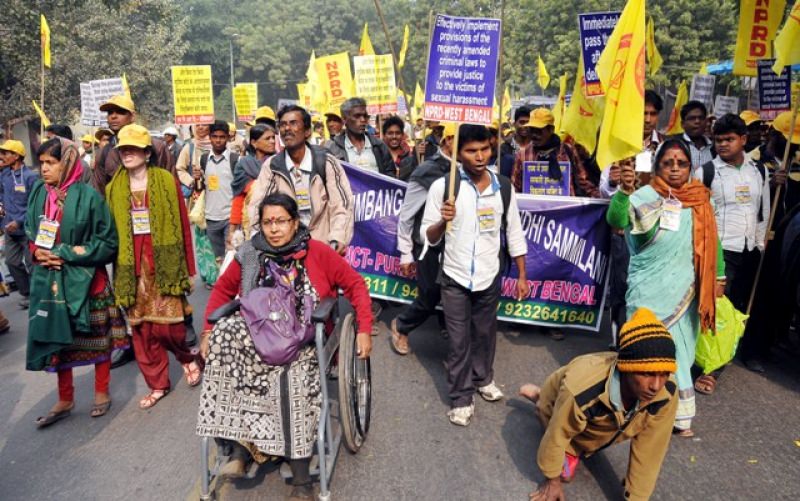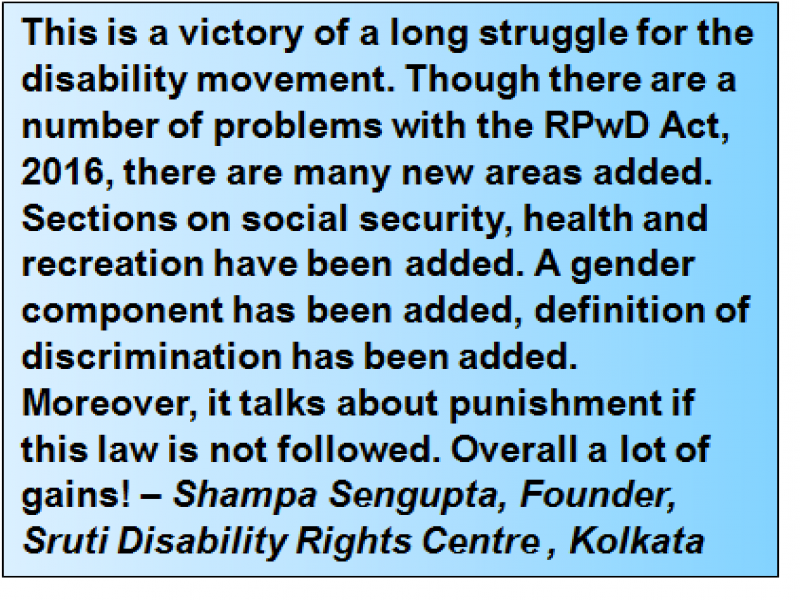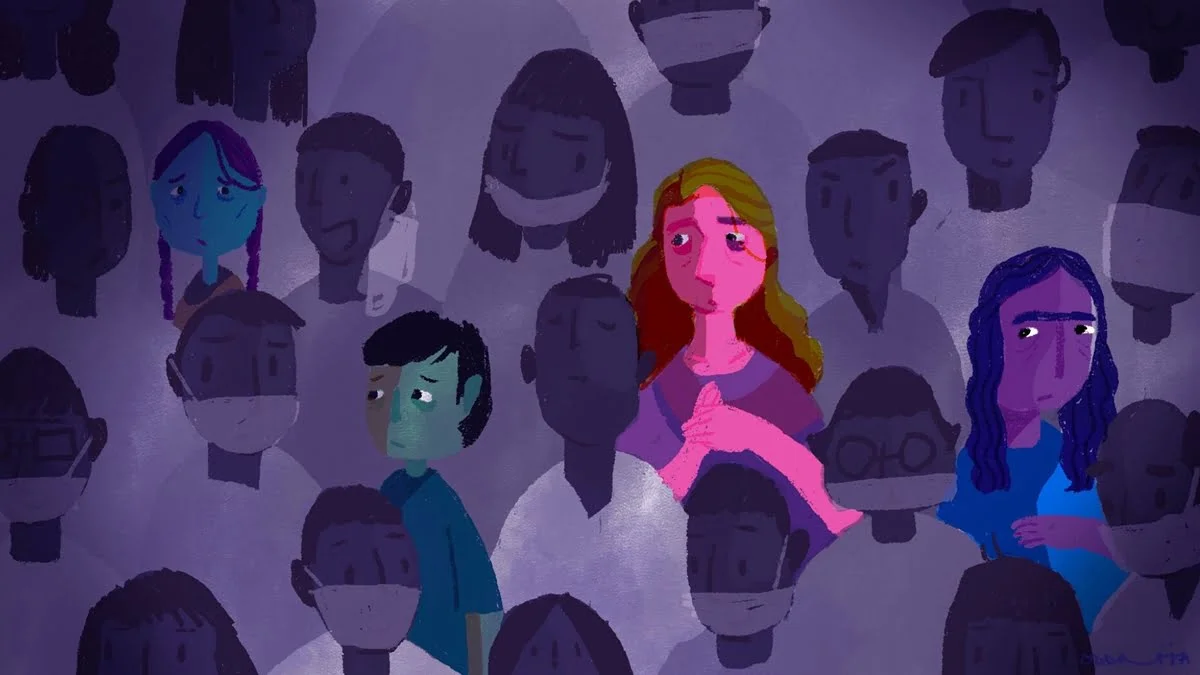December 3rd, 2016 was the day fourteen national disability rights organisations took to the streets demanding the passing of the Rights of Persons with Disabilities Bill, 2014 which had been pending in the Rajya Sabha ever since its introduction almost three years ago. Come December 16th and the winter session of the Parliament saw the passing of the Disability Bill which is now The Rights of Persons with Disabilities Act, 2016. The law, which comes as a landmark victory for the Disability Movement, is an advancement in the Disability Rights Regime in India and has made advances in several areas, particularly with regard to the inclusion of the private sector within the regulatory framework and the provisions for grant of certain benefits in employment, healthcare etc. as well as specific reference to women and children. But there are certain areas where the law misses the mark.
The Background
In 2007 India became a signatory to and ratified the United Nations Convention on Rights of Persons with Disabilities (UNCRPD). The purpose of the said Declaration, as stated, is to promote, protect and ensure the full and equal enjoyment of all human rights and fundamental freedoms by all persons with disabilities, and to promote respect for their inherent dignity. As per the Declaration, persons with disabilities include those who have long-term physical, mental, intellectual or sensory impairments, which in interaction with various barriers may hinder their full and effective participation in society on an equal basis with others. India being one of the first countries to ratify the Convention, it became obligatory to bring about an amendment in the existing laws governing disability rights in order to ensure that the same embodied the spirit and object of the UNCRPD
Following the convention, in 2010, the Ministry of Social Justice and Empowerment set up a committee under Dr. Sudha Kaul to draft a new law for persons with disabilities. Accordingly, the Rights of Persons with Disabilities Bill was introduced by Mallikarjun Kharge in the Rajya Sabha in February, 2014. The Bill which proposes to replace the Persons with Disabilities (Equal Opportunities, Protection of Rights and Full Participation) Act, 1995 was passed by the Upper House of the Parliament on 14th December, 2016, albeit with certain amendments. On 16th December, 2016, the Lok Sabha too passed the Bill, the only business that seems to have been undertaken in the Parliament’s Winter session this year.
Analysing the Key Amendments and Introductions
Certain significant introductions and changes have been introduced to the law governing the rights of persons with disabilities.
- The first of these comes by way of broadening the definition of the term “Disability” which under the 1995 Act has been defined to include 7 conditions. The new Act defines the term as inclusive of 21 conditions, these being Autism Spectrum Disorder; Low Vision; Blindness; Cerebral Palsy; Deaf Blindness; Hemophilia; Hearing Impairment; Leprosy Cured Person; Intellectual Disability; Mental Illness; Locomotor Disability; Muscular Dystrophy; Multiple Sclerosis; Specific Learning Disabilities; Speech and Language Disability; Sickle Cell Disease; Thalassemia; Chronic Neurological Conditions and Multiple Disability. With the inclusion of the amendments proposed by the Rajya Sabha, disabilities resulting from acid attacks as well as Parkinson’s Disease have also been incorporated within the ambit of the revised definition of the term disability. The Act also makes a provision for the central government to notify any other condition as a disability.
- Under the 1995 Act, certain rights and privileges have only been granted to “persons with disabilities” as defined therein, i.e., with 40% disability. The 2016 Act grants rights to all persons with disabilities irrespective of extent of disability
- The Act further defines persons with “benchmark disabilities” as those certified to have at least 40 per cent of the disabilities specified above. These persons can avail of benefits such as reservation in education, employment, other schemes, etc. the quantum of which has been increased from 3% to 4%. Within this context however, questions have been raised regarding Section 33 which speaks of reservation in employment for posts meant to be filled by persons with benchmark disabilities, the argument being that reservation should be against the total number of vacancies, and not the said posts.
- Provisions have also been made for guardianship of mentally ill persons as well as for free legal aid for persons with disabilities.
- The strength of the office of Chief Commissioner of Persons with Disabilities has been increased to include 2 Commissioners and an expert Advisory Committee which will comprise of members from various disability groups.The office of the State Commissioners will also have an Advisory Committee consisting of 5 members.
- Special Provisions for Children: Special emphasis has been laid on children with disabilities and a child between the age of 6 and 18 years possessing benchmark disability shall have the right to free education in educational institutions funded by the Government. Further institutions recognised by the government must provide inclusive education to children with disabilities.
- On Entitlement: An important introduction has been the proposal for setting in place a system for universal certification in order to ensure that Disability certificates are recognised and valid across the country, thus ensuring persons with disabilities are not denied their rights owing to refusal of authorities to accept certificates issued from other States and other administrative issues.
- On Accessibility: “Establishment” under the new law will include private entities thus bringing them within the purview of the Act. The 1995 Act was limited in scope to cover government institutions now also includes private firms and entities making it mandatory for them to conform to the provisions and ensure that persons with disabilities are not discriminated against in matters of employment and are provide all the facilities that help them gain accessibility in public life, including barrier-free access to buildings, transport systems and public infrastructure.
- Introduction of Penal Provisions: Unlike the 1995 Act which did not have any penal provisions for violation of the law, the 2016 Act provides for the punishment by way of fines to be imposed for violation of any of the provisions. It, however does away with the provisions for imposition of a jail term, which has been argues to be a weakening of the provisions of the Bill as originally introduced.
- The Gender Question: The Disability Rights Movement in India has, since its very inception in the 1980s, been critiqued by disabled women as being male-centric in its understanding of Disability. Although the strong presence of the women’s movement in the 1980s and 1990s aided the growth of the disability rights movement in India, the latter failed to take into account the multiple identities that a person with disability may have, a deaf woman for instances, and how their experiences may vary owing to the physical impediments as well as the structural and social barriers of gender. The 2016 seems to be an advancement of law in this context for it takes into account and specifically deals with women with disabilities and makes special mention of the different needs of women with disabilities and provides for benefits in social security, health care etc. The Act, however, in acknowledging diversity, restricts itself to the gender binary, no mention being made of transgenders, who’s struggle for inclusion is further hindered by societies rejection of gender identities that aren’t male or female.
- Extensive Definition, Restrictive Participation: The 1990s was the decade where disability rights movements in India primarily focused on physical disabilities, mental and developmental disabilities largely being left out in the discourse on disability rights. With the introduction of learning and speech impairments in the definition and broadened scope of the term, the law lays down a cross-disability regime of rights. As per the 2011 Consensus, 2.21% of India’s population is persons with disabilities. Of these, 20.3% are persons with movement-related disabilities, 18.8% have vision related disabilities and 18.9% of the remainder have hearing disabilities. With the expansion of the the scope of the law, which will now govern 14 additional disabilities, the figures are bound to change and see in increase in the overall percentage with regard to number persons with disabilities n India. Under the 1995 law, provision had been made for 3% reservation for persons with disabilities in higher education and government jobs, 1% each being reserved for the physically, visually and hearing impaired persons. The original Bill raised the reservation quota to 5% but the Act as passed provides for 4% reservation for persons with disabilities. While the new law makes an attempt to grant protection of rights to persons with disabilities, widening the definition of the term “disability” itself, the reservation quota fixed has only seen a 1% increase and is not proportionate to the number of persons that will now be governed by the act, post the revision of the census definition of disability which determined the numbers in 2011. Thus, while the law includes more persons with disabilities under its protective umbrella, it restricts their participation in public life to a meagre 4%, being counterproductive to the goal of effective participation in society.
- Discrimination defined but legitimised at the hands of the State: Under the 2016 act, Discrimination has been defined to include any distinction, exclusion, restriction on the basis of disability” which impairs or nullifies the exercise on an equal basis of rights in the “political, social, cultural, civil or any other field”. A contentious issue in the new law, however, is Section 3(3) of the 2014 Bill which provides that no person with disability is to be discriminated on the ground of disability, unless it is shown that the impugned act or omission is appropriate to achieve a legitimate aim. There being no reference to what would constitute a legitimate aim, disability rights activists see this as a provision, the interpretation of which if taken to its extremes, would give the State unfettered power to deny the rights of persons with disabilities. The object of the provision is to ensure that the exemptions and privileges are not granted to persons with disabilities in cases where they are not suitable for the post having regard to the type of work carried out etc. However, unless certain Rules and guidelines are laid down for the exercise of such power by the State, it will result in the State having the an arbitrary authority.Though assurances have been given by the Minister of Social Justice & Empowerment with regard to Clause 3(3) that deals with discrimination and Clause 33 concerning employment, the rules governing the same will have to be clearly laid down.
- The Need for a Representative and Authoritative National Commission: The Bill as first introduced in the Rajya Sabha contemplated the setting up of a National as well as State Commissions for persons with Disabilities, granting them the powers of a Civil Court. The Act, however, has retained the offices of the Chief Commissioner and the State Commissioners for Persons with Disabilities. The said offices are to serve as regulatory bodies, monitoring the implementation of the act as well as redressing any grievances that may arise. The proposal for setting up District level Committees under the authority of the States for addressing local concerns has also been accepted. However, the same has not found favour with disability rights activists. While setting up a District Level Forum may be a step in the right direction, the rejection of the demand for a National Forum in favour of the Chief Commissioners Office has drawn some flak. Though the offices of the Chief as well the State Commissioners have been strengthened under the 2016 Act and an attempt has also been made to make them more representative by way of introducing an advisory panel of members from various disability groups, the role has been limited to an advisory one. Disability Rights Activist Dr. Satendra Singh was of the opinion that the office of the Commissioner, being a quasi judicial body is effectively powerless in comparison to the National Commission which if set up would have the powers of a Civil Court. Speaking to Indian Express he stated that “several favourable orders given by the Chief Commissioner have been quashed by the courts on the ground that the Commissioner has no powers and is only a quasi-judicial body.”
- The Aim is to Achieve Social Inclusion: The general understanding of disability in India is influenced by cultural stereotypes, a person with disability being viewed as someone who is an exception to the “normal” and emphasis being laid on curing the condition. The challenge therefore lies in altering social attitudes towards persons with disabilities. Further, the discourse on disability laws and rights in India needs to be in an intersectional context, having regard to the varied experiences of persons with disabilities owing to economic and structural factors as well as social factors and identities that stem from caste, class and gender. The emphasis should be on creating conditions that foster social inclusion and independent existence of persons with disabilities. The disability rights movement in India, like any other identity movement, brings together diverse categories of people advocating for their Right to life with dignity as guaranteed under Article 21 of the Constitution. The demand for active participation and social inclusion needs to be contextualised within the larger picture of deprivation that stems not only from physical or mental disability, but id furthered owing to conditions of unemployment, illiteracy and mobility.
Conclusion
The Rights of Persons with Disabilities Act, 2016, despite its shortcomings, has been applauded by Disability Rights groups as a long awaited advancement from the 1995 law, a rights-based legislation that attempts to take the struggle of disabled community forward The challenge now lies in the effective implementation of the Act, failing which the guarantees and protections it offers will be nothing but hollow promises on paper. The Bill has also been criticized by disability rights activists for not involving persons from within the disability groups in its formulation thus defeating the spirit of the UNCRPD which advocates for the active involvement of persons with disabilities in formulation of policies concerning them.
To quote Mr. Muralidharan, the Secretary of the National Platform for the Rights of the Disabled, from an article in Varta
The overwhelming mood in the disability sector is one of celebration. Implementation will be gigantic task. The department will have to be strengthened to deal with the multitude of tasks that will now arise. One need not be a soothsayer to predict the immense problems with certification. A disability certificate is a basic document for any entitlement. Despite its inadequacies and and some activists clamouring for a more UNCRPD compliant law, it is a big advance over the 1995 act and brings in the rights based perspective.However, the battle for its implementation has to begin in right earnest. And the going, as anybody can guess, will not be smooth.
About the author(s)
Graduate from Lady Sri Ram College & Faculty of Law, University of Delhi. Currently working as a Law Researcher at the High Court Of Delhi.





